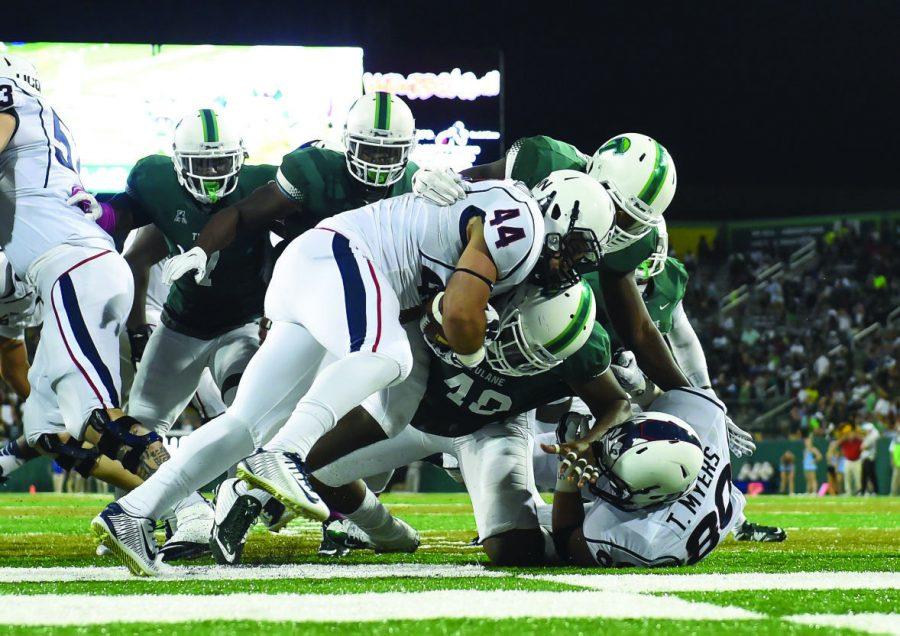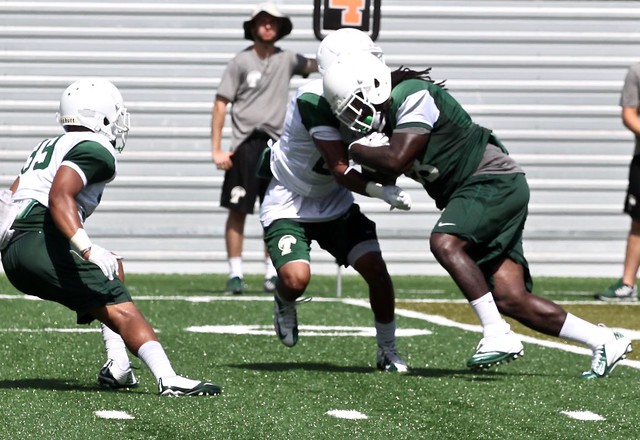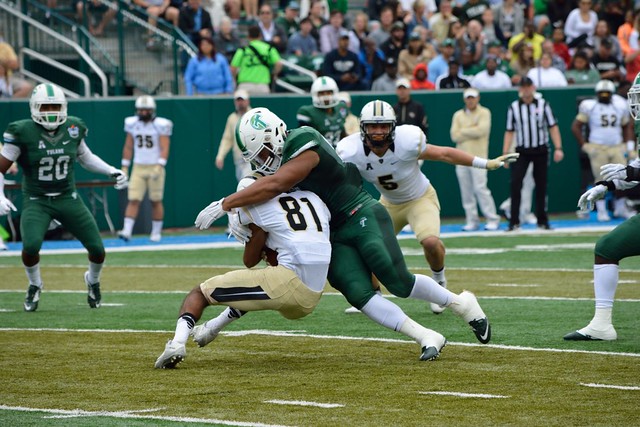Concussion Crisis
The Green Wave team tackles UConn redshirt sophomore running back Max DeLorenzo in a 7-3 Tulane home loss on Saturday, November 7.
November 30, 2015
A healthy brain resembles a bowl of jelly surrounded by strings. But when there is an impact, those strings, or neurons, move or pop and a concussion occurs.
“It’s not always physical damage,” Tulane Assistant Athletic Trainer Alby Lindon said. “It could be a simple stretching or bruising of a neuron where it affects the functioning of the neuron or the chemistry of your brain. That’s essentially what a concussion is, damage to those fibers, whether physical or otherwise, where they don’t function properly.”
A concussion is sometimes difficult to definitively diagnose due to the subjective nature of some tests and potentially conflicting results. With the subjective nature of most concussion testing, athletic trainers and physicians err on the side of caution due to the negative attention football has received in recent years.
While concussions have always been prevalent, the diagnosis was overlooked for far too long. The National Football League refused to acknowledge that football, the sport with the most head injuries, was responsible for brain trauma later in life.
After 2002, when Pittsburgh Steelers starting center Mike Webster died, the American public’s perception of football drastically changed.
Webster’s autopsy, conducted by Dr. Bennet Omalu, proved there was head trauma that was never addressed and led to further deterioration. He called this chronic traumatic encephalopathy, which can cause those with head trauma to suffer dementia later in life.
In 2005, Omalu published the results of his examination in the journal Neurosurgery, but in an effort to protect the NFL, the Mild Traumatic Brain Injury Committee demanded a retraction of the article claiming Omalu wasn’t qualified to make such statements.
Many players suffered due to undiagnosed head trauma and lack of knowledge around the injuries. Dallas Cowboys owner Jerry Jones told ESPN in 2002 that he’d push quarterback Troy Aikman to play through concussions, thereby shortening Aikman’s career.
The lasting effects of sustained head trauma contributed to the deaths of many professional football players. Pittsburgh Steeler offensive lineman Terry Long drank antifreeze in 2005 and an autopsy revealed he suffered from CTE. In 2006, Philadelphia Eagles defensive back Andre Waters died by suicide. The ensuing autopsy revealed Waters, 44 at the time of death, had the brain tissue of an 85-year-old man.
It wasn’t until 2009 that the NFL officially acknowledge the effects of head trauma.
“It’s quite obvious from the medical research that’s been done that concussions can lead to long-term problems,” NFL spokesman Greg Aiello said.
Posters were put up in every professional locker room in 2010, warning players of the effects and announcing penalties and fines for tackles that targeted the head. Two years later, 35 brains of former NFL players were donated to Boston University’s Center for the Study of Traumatic Encephalopathy. Of the 35 brains provided to the center, 34 were found to have CTE.
These deaths from professional football players did not cease. In 2012 New England Patriots linebacker Junior Seau died by suicide with a gunshot to the heart to avoid brain damage. This suicide recalled the 2011 death of Phoenix Cardinals safety Dave Duerson, who shot himself in the chest and sent a text to family requesting his brain be studied for brain trauma.
Due to this rise in awareness, the NFL made many changes and instituted protocols to protect its athletes. The National Collegiate Athletic Association was not far behind in addressing the concussion crisis.
NCAA schools are all required to provide a concussion education to all incoming players with material distributed annually to all athletes. There is also a signed acknowledgement that all parties have read and understand their institution’s concussion management plan. Then comes the pre-participation assessment, recognition of a concussion once an impact has been made and the final step, a post concussion management plan.
Not much is known about concussions, however, since damage to the brain in this regard does not show up with X-ray testing.
“[Since] we don’t know specifically a lot of what a concussion is it’s hard to put a true definition on it. We know it’s an impairment of neurological functions, but beyond that physicians and scientists have yet to come up with a definitive definition. To understand how we implement our concussion management plan at Tulane, you need to start at the beginning [with the baseline testing].”
At Tulane, as well as other collegiate athletic programs, the pre-concussion management plan is made up of a baseline test. Tulane conducts a Sport Concussion Assessment Tool 3-baseline concussion test, where the athletes are asked questions and are given a score based on their responses. There is also a balance component, as well as a testing of cognitive function, concentration, balance and memory. Every school has its own baseline testing protocol that it follows. It is up to the school to decide what form of baseline testing it chooses to enact, due to there being no standard for testing.
When Tulane athletes suffer an impact to the head, they are immediately taken out of play and tested. Trainers run the same tests on athletes that were given to them during baseline testing, to evaluate any differences. The players are also given a symptoms chart to evaluate where they are at in the recovery process. There are 22 symptoms evaluated on a scale of one to six to give trainers both a number of symptoms and a severity score.
The next step is an appointment with Tulane’s team physician, Dr. Gregory Stewart, who makes the final decision. The players, if diagnosed concussed, are not allowed to return to competition until they complete the return to play protocol, which starts when their symptoms have resolved.
Coming back to competition involves a multi-step process that gradually increases activity to ensure that the athletes are not put back into full contact competition until their concussion symptoms have completely subsided.
“If their symptoms stay at zero then they’re allowed to progress to the next level the next day,” Lindon said. “If their symptoms come back at all anywhere in the protocol, then we take a step back and they don’t progress in the protocol until they complete the step without the return of symptoms. It’s a progression to where they eventually are allowed back into full contact practice and competition, but there is no set number of days. It all depends on the severity of their symptoms and how they respond to various steps of our return to play protocol.”
A scandal that shook college athletics to its core and intensified the concussion protocol took place in 2014 with the University of Michigan football team.
It was the fourth quarter in week five, and the Michigan Wolverines were facing off against the Minnesota Gophers when star quarterback Shane Morris dropped back for a pass and suffered a powerful hit by an opposing offensive lineman that dazed him. When he tried to get up, he wobbled around and collapsed into teammates’ arms. Everyone expected him to be taken out of the game, but he continued to play. Head coach Brady Hoke claimed he didn’t know he had a concussion.
“[Morris is] a pretty competitive, tough kid,” Hoke said in an interview with Fox Sports. “And [Morris] wanted to be the quarterback, and so, believe me, if he didn’t want to be he would’ve come to the sideline or stayed down.”
Not all contact on field can be seen, which can result in undiagnosed concussions. A rule that has been created to limit the chances of severe contact is the helmet-to-helmet collision provision. This was instituted following the U.S. Congress investigation into head trauma of football players. This contact is now taken more seriously and intentional collisions are banned.
“The NCAA and the NFL, in an effort to limit concussions, have outlawed helmet-to-helmet on defenseless receivers,” Lindon said. “[The players] weren’t able to brace themselves properly leading to an increase in the force of impact. [Players] can get ejected from a game in college and in the NFL they fine them. They have made rule changes specifically to limit this contact.”
Since this scandal broke, there has been a new protocol instituted to prevent players who have suffered an impact that may have gone overlooked from continuing to play. This new policy however, is only a football mandate.
“Conferences throughout college athletics have started mandating spotters at games,” Lindon said. “The spotter is usually an athletic trainer who sits up in the press box [and is solely] designated to watch the field and look for big hits and players who are exhibiting signs of a concussion or any other injuries.”
Concussion awareness is not something that is going to go away. The public is more aware of head trauma so sports associations are careful to make the players and their families feel as safe as possible.
“I don’t think there’s necessarily been more concussions in recent years,” Lindon said. “What I think is because of public awareness a lot more of them are being diagnosed and talked about. It is becoming a lot more common. 20 or 30 years ago you just got your bell rung and got back out there.”

























Leave a Comment